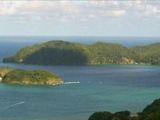There are 42 species of Paradise Bird in the world, out of which 37 live exclusively in the island of New Guinea, the second largest island in the world after Greenland with 786,000 square km.
But surprisingly, it is not New Guinea the one that's called the Bird of Paradise Island, but a minute islet in the Caribbean, named Little Tobago (photo below), located just 3 km (2 miles) off the eastern side of the Tobago island, and having just 2.6 square km, with the highest point at 155 m (470 ft).
Of course, this island is located far away from the natural habitat of the paradise birds.
But in 1909, an Englishman, Sir William Ingram, an owner of cocoa estates in Trinidad, had the idea of colonizing here paradise birds from the species the Greater Bird of Paradise (Paradisea apoda) (photo above). He secured the services of Mr. Wilfred Frost who, in September that year, released 24 males and 24 females on the island. Two females were later added to the colony.
This was a bright idea, as even in its native New Guinea this species is endangered by hunting for its ornamental feathers, worn by native people during their festivities. On May 28th, 1928, a deed was drawn up by the heirs of Sir William Ingram, conveying the island and the Birds-of-Paradise to the Government and People of Trinidad and Tobago.
Since 1929 the islet was declared a natural sanctuary, being totally protected. Visiting it is permitted only for scientific and tourist purposes, only accompanied by guides. The islet is well covered with vegetation and in fact, there is a considerable diversity of flora.
Various palms, shrubs and a variety of other bearing trees produce fruits for these birds, the silver thatched palm being the dominant species.
Banana, papaya and other fruits were cultivated to ensure a constant supply of food for the birds.
Common flowering and fruiting trees found there are: Fiddle Wood, Wild Plantain, Manjack, Bromeliads, Fan Palm, Hog Plum, Cabbage Palm, Naked Indian, Dogroot, Heliconia spp., Cordia collococca, Coccothrinax australis, Spondias mombin, Roystonea oleracae, Bursera simaruba, Lonchocarpus domingensis.
This islet is a heaven for a number of other bird species, too, including the Red billed Tropicbirds, Mot-mot, Hummingbirds, Feral Fowls, Gulls, Yellow Tail Orioles, Bare-eye Thrush, Wrens, Pigeons and Boobies. Here termites, spiders, scorpions, centipedes, earthworms, bats, snails, hermit crabs, snakes and lizards are also found. Notably, the Bird of Paradise species has not been sighted since 1981, being considered extinct in this location.
The island is the only place where the Bird Of Paradise ever existed outside of its natural habitat, New Guinea and surroundings.

 14 DAY TRIAL //
14 DAY TRIAL // 
